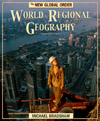 |  World Regional Geography: The New Global Order Update, 2/e Michael Bradshaw,
College of St. Mark and John
Anglo America
Chapter OutlineUse this outline to increase
your understanding of the important characteristics of Anglo America. - New World Core -- This
region continues its leadership position within the world economy.
- New Cultures -- After
1492, the cultures of the New World were overwhelmed by European cultures.
- Native Americans --
The natural environment affected the numbers of Native Americans and how
they lived.
- European Settlers --
Spanish, French, and Dutch colonial areas are eventually replaced
by expanding British colonialism.
- Wealth of Natural Resources
-- Abundant arable land and numerous minerals led to industrialization and
economic development. Colder climate causes Canada to initially lag behind
the U.S.
- Human Resources --
Immigrants to Anglo America brought initiative and ambition that under the
democratic freedoms led to technological innovation and the creation of
wealth.
- World Roles -- After
becoming world political and economic leader, the U.S. has recently entered
into trade agreements with Canada and Mexico.
- Problems of Affluence
-- Differences between the rich, the moderately rich, and the poor are substantial
and growing. These differences affect patterns within cities and between
rural and urban areas. Affluence also contributes to environmental damage.
- World Issue: Gentrification
-- The migration of higher income households into poor inner city areas does
help to rebuild neighborhoods, but the overall impact so far has been modest,
and dispossessed groups have had to move.
- Natural Environment --
This region has a wide variety of environments with Canada's more northern
location providing a major challenge.
- Tropical to Polar Climates
-- Several different climatic types are currently important. In the past,
glaciation was significant.
- Mountains and Plains
-- Many upland areas are found east and west of the central lowlands. The
Canadian Shield underlies half of Canada and has little soil and many minerals.
- Major Rivers and the
Great Lakes -- This region contains many sources of water and routes for
transportation.
- Varied Natural Vegetation
and Soils -- The best soils are found in the interior plains
- Natural Hazards --
Many natural hazards like floods, earthquakes, and hurricanes are found
in this region.
- Environmental Problems
-- Mining, farming, and manufacturing create many environmental problems
like soil erosion and acid rain.
- United States of America
-- This country is the leading free market economy and has a federal system
of government.
- Variety of Regions
-- New England with early manufacturing and major universities; Megalopolis
with many large cities and the national capital; Manufacturing Belt producing
many different industrial products; Appalachia with coal and economic problems;
Midwest and Great Plains with great production of crops and livestock; the
South with cultural distinctiveness and economic improvement; the Western
Mountains with rugged topography, dryness, and few people; Pacific Coast
as a relatively new national core with increasing Asian links; and outlying,
strategic Alaska and Hawaii are the regions of this diverse country.
- People -- The U.S.
has many large metropolitan areas. The origins of immigrants changed over
time and immigration remains a continuing issue and source of population
growth. Hispanics will become more numerous than African Americans and Native
American groups are slowly making economic progress.
- Economic Development
-- Having the largest GDP of any country by far, the U.S. has the greatest
variety of economic activity. Manufacturing based on minerals and transportation
became very successful, but services and information-related activities
are now more important. Commercial agriculture is also well developed. Government
assistance occasionally aided economic development with programs like the
Tennessee Valley Authority.
- Living in the United
States of America -- Many Americans enjoy a high standard of living, leisure
activities, mobility, large homes, many educational opportunities, and sophisticated
health facilities.
- Canada -- Canada, for
better and for worse, is greatly affected by its neighbor to the south.
- Regions of Canada --
Differences threaten unity in Canada. The Atlantic Provinces struggle economically,
whereas Quebec considers independence. Ontario is the economic heart of
Canada and the best climate, and the Prairie Provinces produce wheat and
livestock. British Columbia is isolated from the rest of Canada.
- People -- Canada's
population growth is similar to that of the U.S. and the western areas grow
the most. Independence movements in Quebec and treatment of native Eskimos
or Inuits are additional issues.
- Economic Development
-- An affluent country, Canada's economy includes many primary products,
import substitution industries, and many ties with the U.S.
- Landscapes of Anglo America
-- Urban areas in the U.S. developed distinctive land use patterns including
ghettos and multiple nuclei. Suburbanization and gentrification continue to
occur. Canadian cities are similar to American cities, but more urban planning
took place in Canada as in Toronto. Rural landscapes of both countries contain
many parks and other preserves.
- Future Prospects -- The
United States has been successful in maintaining its position in technology,
trade, and politics. How dominant the U.S. will be in the future is unclear.
Both countries have continuing ties with Europe and increasing connections
with East Asia.
|
|



 2002 McGraw-Hill Higher Education
2002 McGraw-Hill Higher Education